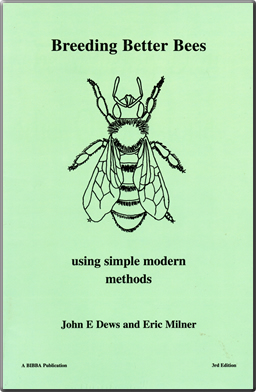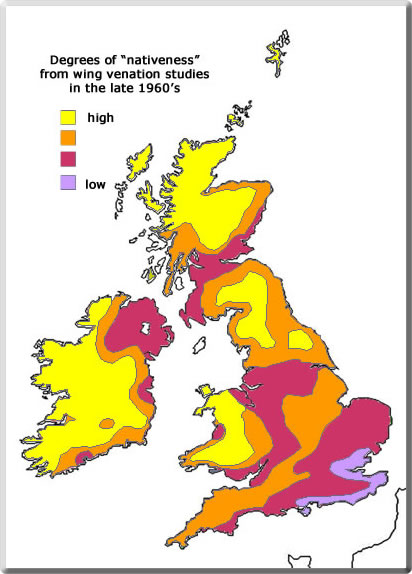Characteristics of the black bee
Nativeness

Further Literature
Two further books which deal exclusively with the black bee are shown; these are again published by BIBBA. Both give a valuable insight in the characteristics and behaviour of the black bee.
Beowulf Cooper in his book "The honey bees of the British Isles" list 23 characteristics which taken together define the back bee. He describes each character in detail. I list below some of these characteristics which might be easily observed (the numbers are taken from the book). Reference will be made to these characteristics throughout the text with the green colour coding.
My own experiences with the black bee are described under the headings in the menu above.
Two further books which deal exclusively with the black bee are shown; these are again published by BIBBA. Both give a valuable insight in the characteristics and behaviour of the black bee.
Beowulf Cooper in his book "The honey bees of the British Isles" list 23 characteristics which taken together define the back bee. He describes each character in detail. I list below some of these characteristics which might be easily observed (the numbers are taken from the book). Reference will be made to these characteristics throughout the text with the green colour coding.
My own experiences with the black bee are described under the headings in the menu above.
Physical characters
1. The bees are "black".
2. Long abdominal overhairs.
3. Characteristic wing type (discordal shift and cubital index)
4. Genetically large size.
Behavioural characters
5. Low temperature flight
8. Longevity
9. Non-prolificacy
10. Heavy spring to summer pollen storage
11. Heavy late summer pollen storage.
12. Early cessation of brood rearing in the summer.
13. Thriftiness.
14. Adaptation to the local flora.
15. Tight winter clustering near the hive entrance.
16. Comb honey cappings white and convex.
17. Compact brood pattern,
18. Compact honey storage pattern.
19. Fluctuating brood nest temperature.
20. Minimal drifting.
21. Drones expelled earlier.
22. Alternative mating behaviour.
23. Temperament compatible with other native bees.
1. The bees are "black".
2. Long abdominal overhairs.
3. Characteristic wing type (discordal shift and cubital index)
4. Genetically large size.
Behavioural characters
5. Low temperature flight
8. Longevity
9. Non-prolificacy
10. Heavy spring to summer pollen storage
11. Heavy late summer pollen storage.
12. Early cessation of brood rearing in the summer.
13. Thriftiness.
14. Adaptation to the local flora.
15. Tight winter clustering near the hive entrance.
16. Comb honey cappings white and convex.
17. Compact brood pattern,
18. Compact honey storage pattern.
19. Fluctuating brood nest temperature.
20. Minimal drifting.
21. Drones expelled earlier.
22. Alternative mating behaviour.
23. Temperament compatible with other native bees.


Degrees of Nativeness
The map was adapted from information given by Beowulf Cooper in his book "The Honeybees of the British Isles". It shows the degrees of "nativeness" of A. m. mellifera from wing venation studies in the 1960's.
With regards to Ireland it is interesting to note the presence of bees with a 'low degree of nativeness' in the north, around Dublin on the east coast, and Cork on the south coast.
In 2008 the Federation of Irish Beekeepers voted to promote the conservation of the native dark bee A. m. mellifera into its constitution. Leading the way to have the whole of the island of Ireland declared a reserve for A. m. mellifera.
Natural selection should tend to eliminate foreign genes by adapting the black bee to the local environment, and the black bees itself would have its own mechanisms for genetic isolation.
My own bees originally originated from that area around Cork (red) which on the map was shown to be low in the 'degree of nativeness'. I was particularly interested to find out if indeed there had been a change in the last 60 years.
Beekeepers have been encouraged in the past to perform a morphometric analysis in order to decide which is the best black queen to use for breeding. However, times seems to have changed. It would appear that morphormetric analysis has now gone out of fashion and beekeepers are being encouraged to breed from colonies that are 'locally adapted'.
Researchers now are able to use microsatellite analysis to get a much more detailed profile of honey bee genetics in any colony. An example is shown below.
The map was adapted from information given by Beowulf Cooper in his book "The Honeybees of the British Isles". It shows the degrees of "nativeness" of A. m. mellifera from wing venation studies in the 1960's.
With regards to Ireland it is interesting to note the presence of bees with a 'low degree of nativeness' in the north, around Dublin on the east coast, and Cork on the south coast.
In 2008 the Federation of Irish Beekeepers voted to promote the conservation of the native dark bee A. m. mellifera into its constitution. Leading the way to have the whole of the island of Ireland declared a reserve for A. m. mellifera.
Natural selection should tend to eliminate foreign genes by adapting the black bee to the local environment, and the black bees itself would have its own mechanisms for genetic isolation.
My own bees originally originated from that area around Cork (red) which on the map was shown to be low in the 'degree of nativeness'. I was particularly interested to find out if indeed there had been a change in the last 60 years.
Beekeepers have been encouraged in the past to perform a morphometric analysis in order to decide which is the best black queen to use for breeding. However, times seems to have changed. It would appear that morphormetric analysis has now gone out of fashion and beekeepers are being encouraged to breed from colonies that are 'locally adapted'.
Researchers now are able to use microsatellite analysis to get a much more detailed profile of honey bee genetics in any colony. An example is shown below.
In an update to this information reference should be made to an article published in 2018.
A significant pure population of the dark European honey bee (Apis mellifera mellifera) remains in Ireland [33].
Here data from mitochondrial DNA and microsatellite analysis was used; it was concluded "this study presents the first comprehensive genetic analysis of the indigenous population of A. m. mellifera on the island of Ireland. Data from 412 honey bees from 80 sampling sites across 24 counties shows the existence of a highly pure breeding population throughout the island. This is evident in that 97.8% of Irish samples were assigned to the subspecies with a probability of 0.96, when a probability of 0.90 indicates purity"
A significant pure population of the dark European honey bee (Apis mellifera mellifera) remains in Ireland [33].
Here data from mitochondrial DNA and microsatellite analysis was used; it was concluded "this study presents the first comprehensive genetic analysis of the indigenous population of A. m. mellifera on the island of Ireland. Data from 412 honey bees from 80 sampling sites across 24 counties shows the existence of a highly pure breeding population throughout the island. This is evident in that 97.8% of Irish samples were assigned to the subspecies with a probability of 0.96, when a probability of 0.90 indicates purity"